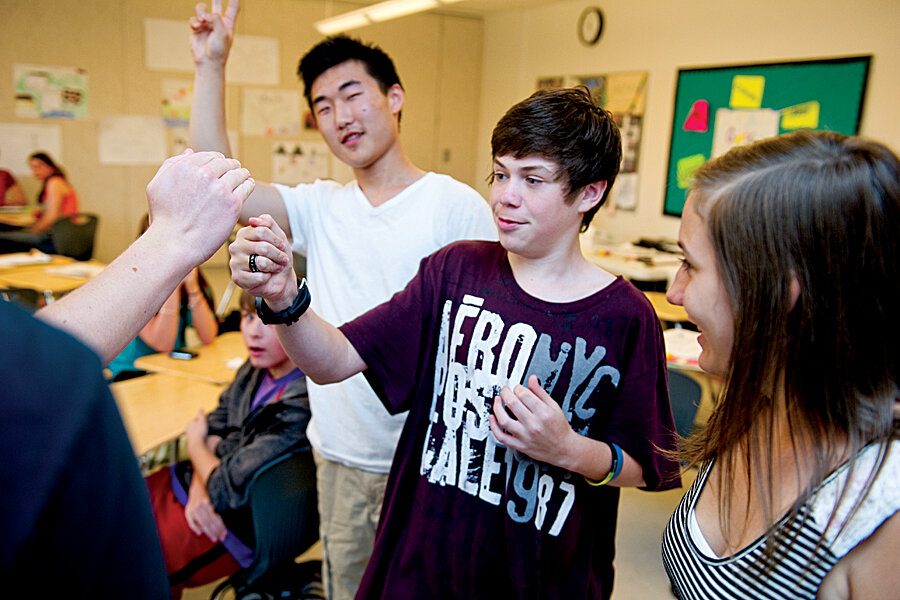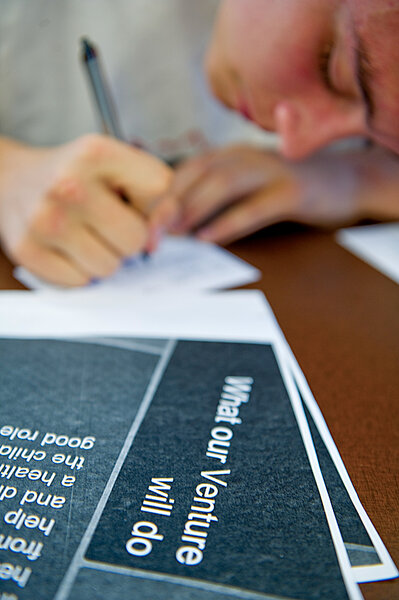Is your student 'competent'? A new education yardstick takes the measure.
Loading...
| Kingston, N.H.
Grading at Sanborn Regional High School in Kingston, N.H., is not influenced by some of the more traditional factors, such as turning in homework on time or doing "extra credit." Instead, each class defines a set of about four "competencies" – central concepts and skills – and a student must be proficient in each one to pass. Stellar performance in one can't make up for lack in another.
Students here have multiple opportunities along the way to show teachers what they know: There are quizzes and tests, yes, but also projects, individual portfolios, and class performances.
Spelling out what students need to demonstrate to earn passing or high grades "takes the subjectivity out of it," says Sanborn English teacher Aaron Wiles. A student tripping over one math concept gets pinpointed help, rather than accumulating gaps in understanding and having to take the entire course again. Students reflect on and revise their work until they meet expectations. "They take ownership of it," Mr. Wiles says.
This approach to learning is known as competency-based education, and New Hampshire is among the pioneers. As it gains momentum around the United States, the expectation is that it will deepen learning and tie education more explicitly to skills that will equip students for the workplace and college-level studies – everything from accurate math and writing to creative problem-solving. Competency education can be done in a variety of ways and across all subjects, but it takes a different mind-set than simply marching through a textbook-based curriculum.
Sixty-five percent of jobs in America will require some college-level study by 2020, according to the Georgetown University Center on Education and the Workforce. The majority of states have signed on to Common Core State Standards in English and math as a way to ensure that successful students won't have to do remedial work in college. Student tests being developed to go along with these standards aim to probe more deeply than traditional multiple-choice standardized tests by giving students tasks that require them to solve problems and apply what they've learned. Schools with a competency-based approach have already been doing that across a wide range of subjects.
Advocates also see it as a promising way to personalize learning and to break out of the traditional classroom and school calendars, which move students through on the basis of age and "seat time." New Hampshire and several other states are building flexibility into their systems so students can advance and graduate when they are ready, not because they've spent a certain number of days in courses.
"Grouping kids by birthday was convenient 100 years ago because we didn't have a better way to organize a system of public education ... [but] when we think about next-generation models ... [students] should progress when they've demonstrated they've mastered important concepts," says Tom Vander Ark, an educator and director at the International Association for K-12 Online Learning, a nonprofit in Washington that supports competency-based education.
After a pilot program that started in 1997, all of New Hampshire's public high schools were required to tie graduation to competency assessments by 2008-09. Similar work is under way in Grades K through 8. The state is starting to harvest the fruits of this shift. Although it's difficult to isolate the effects of competency-based education from other policies, state officials say dropout rates have declined and graduation rates have increased at higher rates in schools that were early to embrace the competency approach.
Schools such as Sanborn Regional High report lower levels of class failure and discipline problems than previously experienced. The number of courses that its freshmen failed, for instance, was 72 in 2010-11 – the year just before full implementation of the school's competency system – and dropped to 26 in 2012-13.
Another measure of results: Among 165 Expeditionary Learning Schools around the US, a network that incorporates a competency approach, students reach proficiency on standardized reading tests at a rate that is 11 to 12 percentage points higher than that of their district peers. In math, their scores are eight to nine points higher.
Because competency-based systems haven't been implemented or studied on a large scale, only time will tell how well students taught that way fare in college or careers compared with their peers. But more states are moving to adopt the approach, including Oregon, Maine, Kentucky, Arizona, and Iowa.
Moreover, when individual school districts competed for a recent round of Race to the Top grants from the federal government, 75 percent of the winners included competency-based elements in their plans, according to KnowledgeWorks, an education nonprofit group that supports competency-based reforms.
A peek at how it works in practice
In Sanborn High's freshman Global Studies classes, a role-playing exercise gives students a chance to build on several of the class competencies, such as understanding the role of conflict and cooperation among individuals and governments and applying knowledge of geography.
For the unit on World War I, before students have a single lecture or reading assignment, they experience the tangled alliances that helped spark the war. During a June class, teachers Brian Gray and Mark Giuliucci divvy up their students into teams representing six fictional countries on a map resembling the Balkan Peninsula. The countries can make four types of alliances: nonaggression, right of passage, mutual defense, or mutual support. The last one is "where you literally will go to war with them if they go to war.... You are like BFFs," Mr. Gray tells them.
Students have already created flags and anthems. Now they are scurrying around, seeking beneficial treaties with each other and strategizing in secret hallway meetings.
A few minutes into the exercise and Brianna DeRosier, secretary of state for Yorkton, exclaims: "This is so stressful!" One country won't forge a sought-after alliance, so she must shift gears. By the end of the class period, the ponytailed teenager wearing a zebra-stripe belt has already gotten a better grasp on conflict.
"I didn't really know what caused wars," Brianna says. "I knew it was conflict, but I didn't really understand why – I was like, why can't everybody just get along? But now I understand that there are other parts to it, with the allies, and sneaking around each other's back."
The simulation takes several class periods and drives home lessons on nationalism, geography, economics, military strategy, and culture, so when the teachers incorporate the facts of World War I, students can take away more than just a string of events. "It's teaching kids more to look at situations and predict," Gray says.
When Sanborn students aren't on track to meet a class competency, they are expected to keep working at it during flexible periods designed to reteach key elements. "When the teacher actually comes up to you and teaches you how to do it by yourself," freshman Julia Melvin says, "sometimes you get it easier, and then they'll give you [an assignment] and usually you get a way better grade."
Enrichment opportunities can be created for students who more quickly master the competencies.
One key to the competency approach has been grouping teachers together so they can collaborate on activities, assessments, and promoting the success of the students they share, says Sanborn Principal Brian Stack. By contrast, in many schools teachers work largely in isolation.
The transition also required communicating with parents, some of whom have looked askance at a grading system that does not reward behaviors such as getting homework in on time, Mr. Stack says. But parents – and college admissions representatives – end up appreciating report cards that specify areas within each subject where a student meets standards, needs work, or is excelling, he adds.
One concern that surfaces among skeptics is that "done poorly, [competency-based education] becomes a checklist of skills rather than engaging young people in big questions and challenging them to think big thoughts," Mr. Vander Ark says. But the latter is what happens if it's done well, he says.
Students in charge of their own learning
The small Making Community Connections Charter School in Manchester, N.H., has taken the concept even further than Sanborn, which still generally groups students in grade levels. At the charter school, students enter between ages 13 and 16, and move along the path to graduation not based on grade levels or school years but on public exhibits whenever they are ready to prove their competencies to move to a new level. Some zip through high school in two years, others may take six (refugees who missed a lot of formal schooling, for instance).
They earn credits through internships with local businesses and by making "treks" for research in the community, presenting personal projects on topics they choose, and attending "learning studios" where teachers oversee interdisciplinary work.
Students initially learn "what it means to be the person in charge of your learning," says chief education officer Kim Carter, who has focused on competency-based education for decades. "They have to apply, document, and defend their learning, and later, design it, too. It's a big shift from the teacher telling you what to do."
Rowan Brantley previously attended a local middle school and says she didn't do well there. By contrast, "there's a lot of choice here, so if I have an issue with a class or I'm not learning the way I want to, I can change that," she says.
She and several schoolmates gave a May presentation to adults in the community to earn a $1,000 grant to start a club for mentoring younger students and making and selling T-shirts with socially conscious messages. Teachers ensure that educational standards are woven into such activities, but when students are so engaged in meaningful projects, Ms. Carter says, "learning becomes almost incidental to them.... It's more like the way people learn in life, outside of school."








